Abstract
1. The nature of the nerve-mediated contractions in the urethral smooth muscle from the rabbit was studied in vitro. Field stimulation caused smaller contractile responses than in the detrusor of the rabbit. 2. There was no significant difference in response to field stimulation or exogenous agents acting on adrenoceptors between longitudinal and circular strips from the rabbit urethra. Histological studies showed that the urethral muscle is arranged in three layers, which run circularly and longitudinally. 3. Atropine had very little effect on the response to field stimulation, phentolamine almost abolished the contractile response to nerve stimulation and sometimes unmasked a relaxation. 4. The alpha 1-adrenoceptor blocking agent, prazosin, blocked both the contractile response to the alpha 1-receptor agonist phenylephrine and that to intrinsic nerve stimulation, with similar potencies. The alpha 2-blocking agent yohimbine shifted the dose-response curve of the contractile response to the alpha 2-agonist, clonidine, in a dose-dependent manner, 10(-7) M causing a 10 fold shift. This concentration had no effect on the response to intrinsic nerve stimulation, suggesting that alpha 2-receptors are not involved in the response. Higher concentrations of yohimbine caused a suppression of the nerve-evoked response which is assumed to be non-specific. 5. Noradrenaline, phenylephrine, and clonidine caused dose-dependent contractile responses in the rabbit urethral strips. The contractions induced by clonidine developed more slowly than those induced by noradrenaline and phenylephrine. 6. These results demonstrate that the rabbit urethral smooth muscle contains both alpha 1- and alpha 2-adrenoceptors, and the nerve-mediated contraction of the rabbit urethra is adrenergic in nature and mediated mainly via alpha 1-adrenoceptors.
Full text
PDF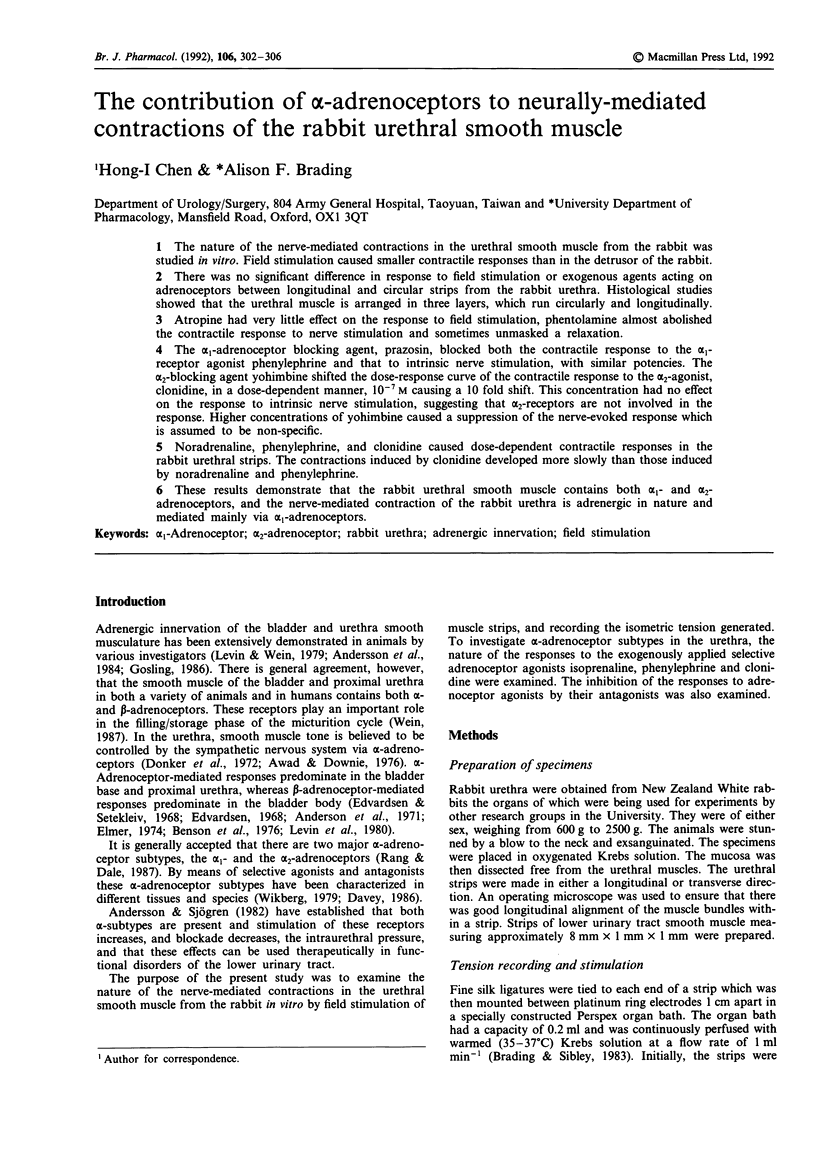
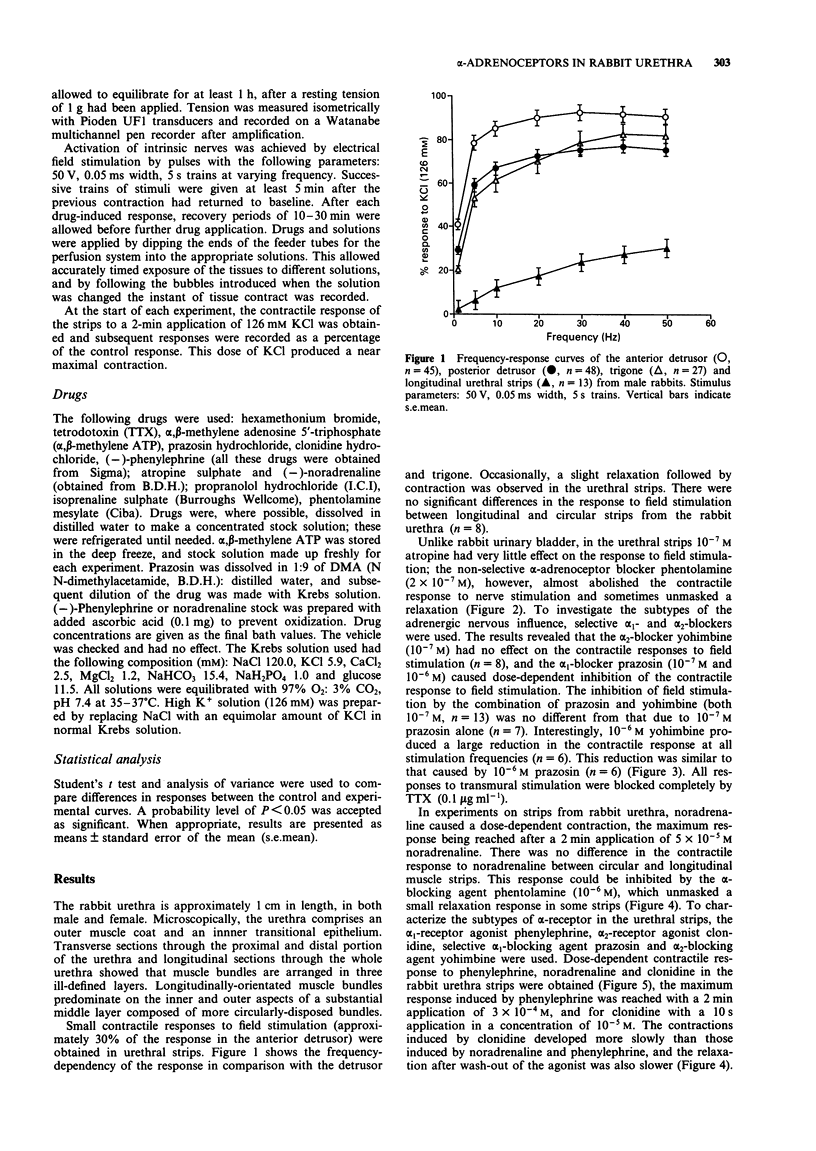
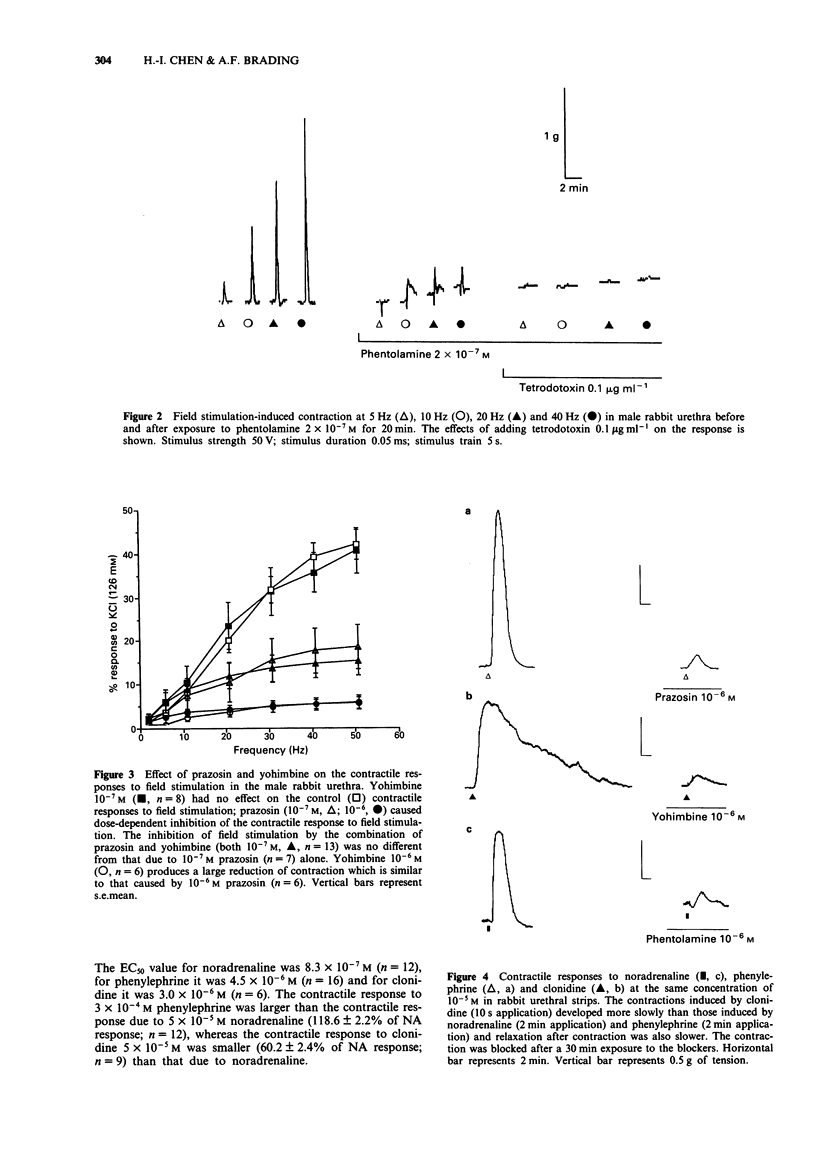
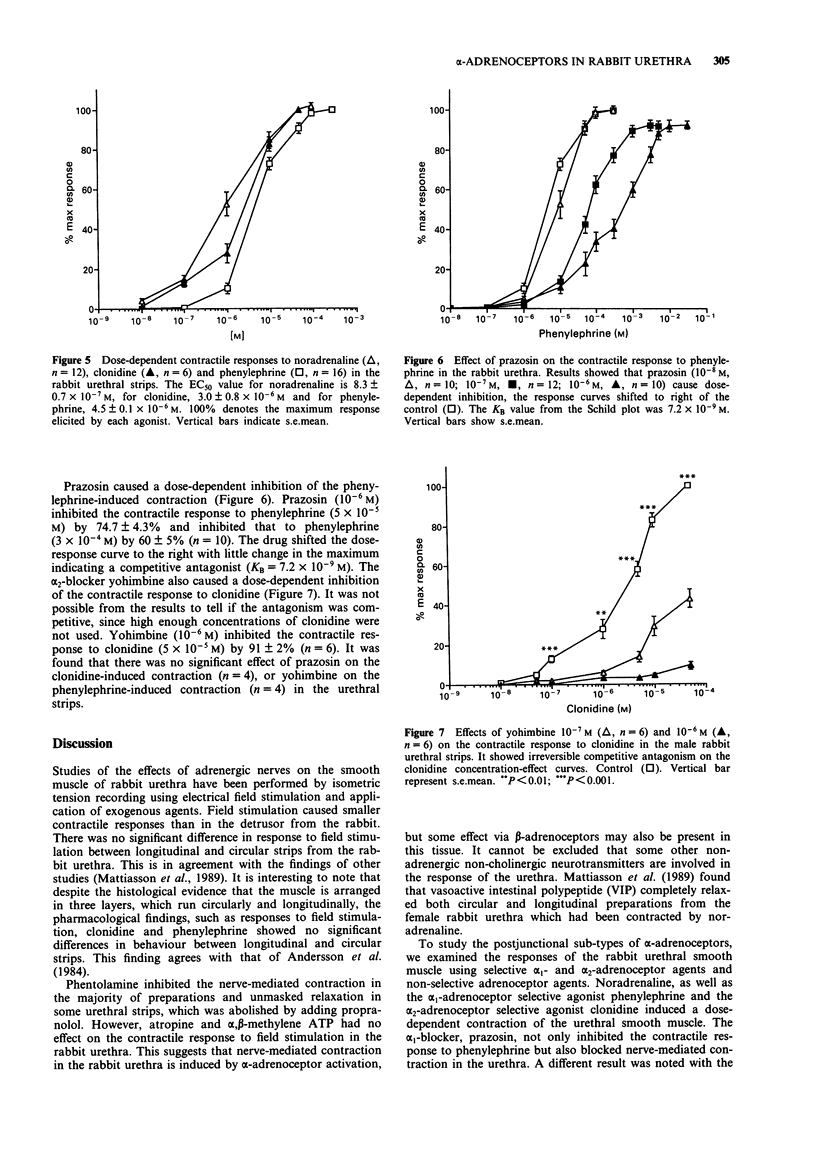
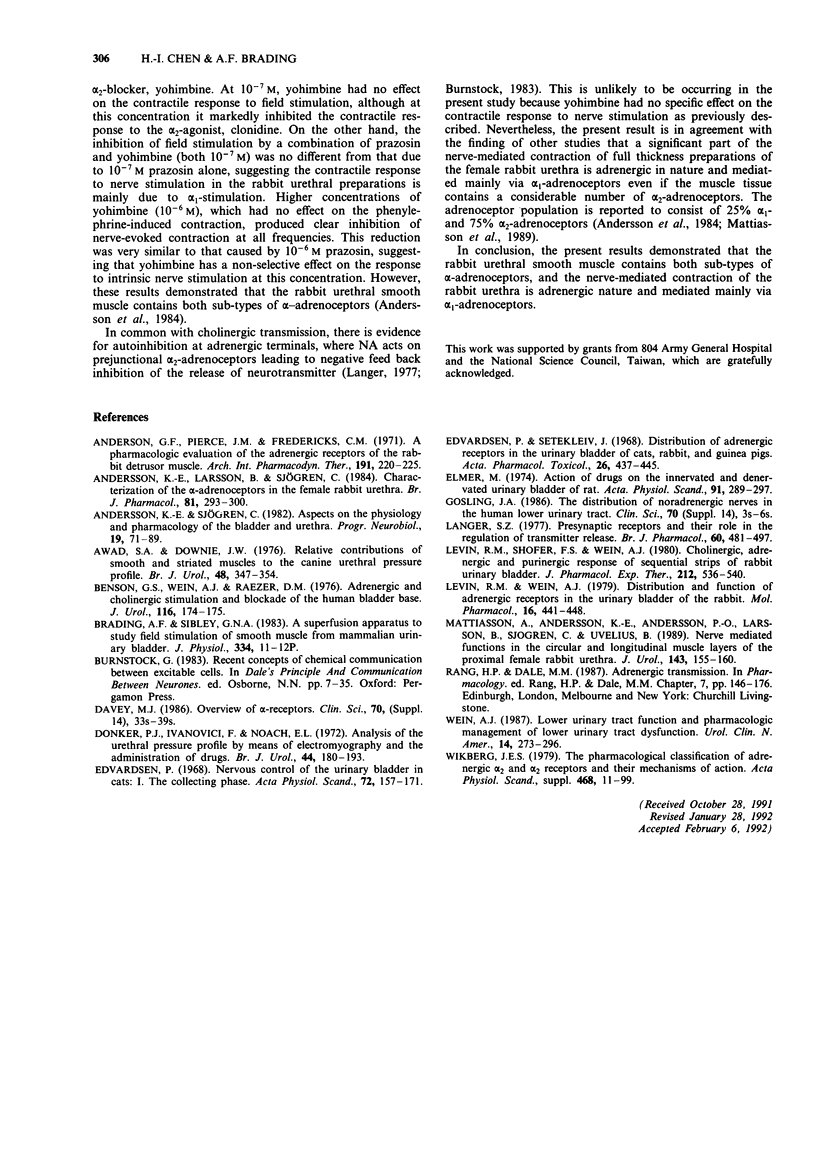
Selected References
These references are in PubMed. This may not be the complete list of references from this article.
- Anderson G. F., Pierce J. M., Fredericks C. M., Atkinson S. M., Goellner P. A pharmacologic evaluation of the adrenergic receptors of the rabbit detrusor muscle. Arch Int Pharmacodyn Ther. 1971 Jun;191(2):220–230. [PubMed] [Google Scholar]
- Andersson K. E., Larsson B., Sjögren C. Characterization of the alpha-adrenoceptors in the female rabbit urethra. Br J Pharmacol. 1984 Feb;81(2):293–300. doi: 10.1111/j.1476-5381.1984.tb10078.x. [DOI] [PMC free article] [PubMed] [Google Scholar]
- Andersson K. E., Sjögren C. Aspects on the physiology and pharmacology of the bladder and urethra. Prog Neurobiol. 1982;19(1-2):71–89. doi: 10.1016/0301-0082(82)90021-1. [DOI] [PubMed] [Google Scholar]
- Awad S. A., Downie J. W. Relative contributions of smooth and striated muscles to the canine urethral pressure profile. Br J Urol. 1976 Oct;48(5):347–354. doi: 10.1111/j.1464-410x.1976.tb06651.x. [DOI] [PubMed] [Google Scholar]
- Benson G. S., Wein A. J., Raezer D. M., Corriere J. N., Jr Adrenergic and cholinergic stimulation and blockade of the human bladder base. J Urol. 1976 Aug;116(2):174–175. doi: 10.1016/s0022-5347(17)58733-9. [DOI] [PubMed] [Google Scholar]
- Davey M. J. Overview of alpha-receptors. Clin Sci (Lond) 1986;70 (Suppl 14):33s–39s. doi: 10.1042/cs070s033. [DOI] [PubMed] [Google Scholar]
- Donker P. J., Ivanovici F., Noach E. L. Analyses of the urethral pressure profile by means of electromyography and the administration of drugs. Br J Urol. 1972 Apr;44(2):180–193. doi: 10.1111/j.1464-410x.1972.tb10064.x. [DOI] [PubMed] [Google Scholar]
- Edvardsen P. Nervous control of urinary bladder in cats. I. The collecting phase. Acta Physiol Scand. 1968 Jan-Feb;72(1):157–171. doi: 10.1111/j.1748-1716.1968.tb03838.x. [DOI] [PubMed] [Google Scholar]
- Edvardsen P., Setekleiv J. Distribution of adrenergic receptors in the urinary bladder of cats, rabbits, and guinea-pigs. Acta Pharmacol Toxicol (Copenh) 1968;26(5):437–445. doi: 10.1111/j.1600-0773.1968.tb00462.x. [DOI] [PubMed] [Google Scholar]
- Elmér M. Action of drugs on the innervated and denervated urinary bladder of the rat. Acta Physiol Scand. 1974 Jul;91(3):289–297. doi: 10.1111/j.1748-1716.1974.tb05685.x. [DOI] [PubMed] [Google Scholar]
- Gosling J. A. The distribution of noradrenergic nerves in the human lower urinary tract. Clin Sci (Lond) 1986;70 (Suppl 14):3s–6s. doi: 10.1042/cs070s003. [DOI] [PubMed] [Google Scholar]
- Langer S. Z. Sixth gaddum memorial lecture, National Institute for Medical Research, Mill Hill, January 1977. Presynaptic receptors and their role in the regulation of transmitter release. Br J Pharmacol. 1977 Aug;60(4):481–497. doi: 10.1111/j.1476-5381.1977.tb07526.x. [DOI] [PMC free article] [PubMed] [Google Scholar]
- Levin R. M., Shofer F. S., Wein A. J. Cholinergic, adrenergic and purinergic response of sequential strips of rabbit urinary bladder. J Pharmacol Exp Ther. 1980 Mar;212(3):536–540. [PubMed] [Google Scholar]
- Levin R. M., Wein A. J. Distribution and function of adrenergic receptors in the urinary bladder. Mol Pharmacol. 1979 Sep;16(2):441–448. [PubMed] [Google Scholar]
- Mattiasson A., Andersson K. E., Andersson P. O., Larsson B., Sjögren C., Uvelius B. Nerve-mediated functions in the circular and longitudinal muscle layers of the proximal female rabbit urethra. J Urol. 1990 Jan;143(1):155–160. doi: 10.1016/s0022-5347(17)39901-9. [DOI] [PubMed] [Google Scholar]
- Wein A. J. Lower urinary tract function and pharmacologic management of lower urinary tract dysfunction. Urol Clin North Am. 1987 May;14(2):273–296. [PubMed] [Google Scholar]


